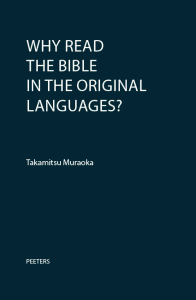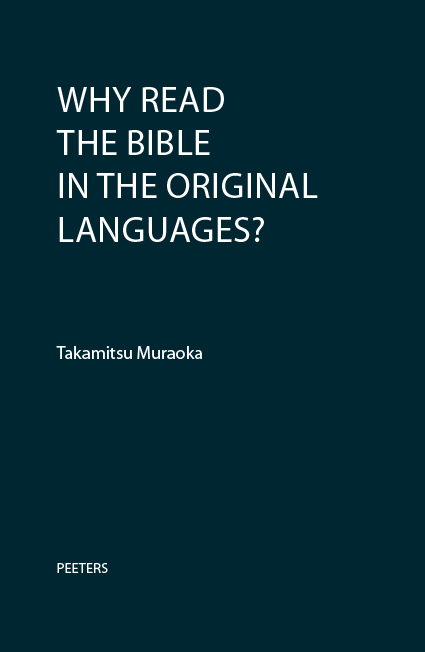Muraoka, Takamitsu. Why Read the Bible in the Original Languages? Leuven: Peeters, 2020, pp 106, $24.00, Paperback.
Takamitsu Muraoka received a PhD from Hebrew University in 1970 and has served as a lecturer on Semitic languages at Manchester University, professor of Middle Eastern Studies at Melbourne University, and chair of Hebrew, Israelite Antiquities, and Ugaritic at Leiden University. Since his retirement in 2003 he has continued to publish in Semitic and Septuagint studies as well as teach biblical languages and the Septuagint in Asian countries. In 2017 he received the Burkitt Medal for Hebrew Bible studies from the British Academy.
In Why Read the Bible in the Original Languages, Dr. Muraoka seeks to convince readers that when the Bible is read in its original languages “it can be interpreted and analyzed better or differently than when it is read in this or that modern translation” (7). He introduces the work by sharing his passion for the languages through a brief autobiography. He then outlines two general principles concerning the value of the biblical languages: (a) there are certain aspects of language (such as poetic devices) that can only be seen in the original language, (b) and reading the original language makes one aware of possible alternate interpretations (16). In the rest of the book Muraoka shares insights from Hebrew (chapter 1), Greek (chapter 2), and Aramaic (chapter 3). He concludes with a final chapter on the Septuagint (chapter 4), advocating for its value as a bridge between the Old and New Testaments.
Through many examples Muraoka succeeds in demonstrating a key way the original languages aid biblical interpretation: one can see the biblical author’s emphasis. He notes that since all three biblical languages have the subject of a verb built into its ending, explicit pronouns and repeated references to the subject are unnecessary and therefore indicate focus. One example he gives is the repeated use of David with multiple verbs in 2 Samuel 12:19 to slow down the narrative and highlight David’s response to the death of his child (30). Muraoka also notes that Greek and Hebrew word order, being more flexible than English, often highlights certain ideas or characters. For example, Genesis 22:1 states: “After these things, God tested Abraham,” but the placement of “God” before “tested” is not the expected word order for Hebrew narrative and Muraoka explains that the author is zooming in on God and the surprising event of Him testing a human (25-26). Other aspects of emphasis Muraoka highlights include the use of repetition and the significance of the definite article.
Muraoka also explains important ways the verbal systems of the biblical languages differ from common languages today. He explains that Hebrew verbs have specific endings to indicate the gender of the subject of the verb. This gender correspondence often helps identify the subject of the verb when it could otherwise be ambiguous, such as the various speakers in Song of Solomon (35-36). Most of the chapter on Greek is devoted to the issue of verbal aspect (kind of action). Holding to a tri-aspectual system, he explains the present aspect as portraying continuous action, perfect aspect as portraying an action that has already been completed, and aorist aspect as referring to the action in general without reference to its ongoing or completed nature (72). To demonstrate insights available from aspect he notes that the woman in Luke 7:38 was continually kissing and wiping Jesus’s feet since the verbs are in the present aspect. But when Jesus confronts Simon in verse 45, He highlights the action of kissing in the present aspect while describing the other actions with the aorist aspect. Muraoka also shows how Jesus is not teaching that the woman is forgiven because of what she is doing, but that her sins had already been forgiven (perfect aspect) and her present actions were a demonstration of gratitude for that forgiveness (73-75).
Acknowledging that Aramaic and the Septuagint are likely unfamiliar to the average reader, Muraoka begins chapters three and four with their respective histories to demonstrate the value of studying each discipline. These introductions highlight the complex linguistic milieu behind the Bible and encourage readers to consider the impact of this milieu on our understanding of scripture. He makes a great case for the importance of these two subjects, but the examples used in these chapters do not measure up to the breadth of examples provided for Hebrew.
While this work is primarily for beginning readers, Muraoka expresses his hope that more advanced readers will also benefit from the insights he offers (7). One such insight concerns Judah and Tamar in Genesis 38. Muraoka notes that many translations state Tamar became pregnant ‘from him’ in 38:18 (23). However, he argues that the Hebrew preposition used here (lamed) never means ‘from’ and that Genesis 38:18 should be translated: “she became pregnant for his best interests.” This alternate interpretation, Muraoka argues, paints Tamar as faithfully trying to preserve the promise of offspring given by God to Abraham, an interpretation possibly strengthened by the positive description of Tamar later in scripture (Ruth 4:12, Matthew 1:3). While this interpretation may or may not be correct (Muraoka does not comment on the same preposition in 38:24 where it indicates that Tamar became pregnant by prostitution), it certainly highlights Muraoka’s thesis of various possible interpretations made possible by the original language.
One weakness of this work is its inconsistent organization. There are several sections and paragraphs that appear out of place. One section in the chapter on Aramaic relates more to translation issues in general and not to insights drawn from Aramaic. Muraoka also includes an insightful section on the Greek words for love and a Japanese politician-soldier who adopted the Great Commandment (Matthew 22:35-40) as his life motto. This section, however, seems out of place in the chapter on the Septuagint and might fit better in the chapter on general Greek. There are also several sections where the flow of an example is interrupted by a different idea making it hard to follow Muraoka’s point. These sections would benefit from rearranging and updating so that the insights could be more fully appreciated.
This is a great book for anyone considering investing the time to learn the original languages of scripture. Through this book the reader will become well acquainted with the kinds of insights reading the Bible in its original language can offer. Since Muraoka wrote this book for readers who have no knowledge of the biblical languages (7), he does not use any Hebrew or Greek letters and only rarely refers to specific words in the original languages. Instead, he communicates his points through English translations and explanation. He also avoids many technical grammatical terms unfamiliar to the average reader, and thoroughly explains terms he does include. While this book certainly contains many valuable insights into scripture, readers who have some familiarity with the biblical languages will find more a more thorough overview of potential insights in Exegetical Gems from Biblical Greek, and Exegetical Gems from Biblical Hebrew.
Daniel Graham
Midwestern Baptist Theological Seminary





